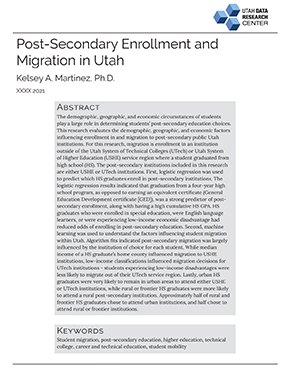Overview
This data narrative explores Utah"s high school graduates (USBE) from 2013 - 2016 and analyzes their enrollment and migration patterns to Utah's colleges.
Following or nearing high school graduation, students are faced with two choices related to post-secondary education:
- Whether or not to enroll in post-secondary education.
- If enrolling, should they attend a college or university close to home or outside their home county?
The demographic, geographic, and economic circumstances of a graduating high school student play a prominent role in each student’s decision to enroll in post-secondary school and enroll for their post-secondary education.
Keep scrolling to view the key findings of Utah"s high school graduates.
Key findings from the report include the following:
- If students enroll in post-secondary school, they most frequently enroll in their home service region.
- Students are more likely to travel a further distance to a main campus if enrolling in a degree-granting institution as compared to a technical college.
- A decision to enroll in post-secondary school inside or outside of a student’s home service region (migration) was primarily influenced by the institution of choice for each student and the student's ACT composite score.
- Students who enrolled in a USHE institution still most frequently chose a school in their home service region.
- Student demographics, such as race, ethnicity, gender, and type of high school graduation - diploma versus GED - and other socioeconomic indicators, play an important role in post-secondary enrollment.
- Students from low-income families, learning English, or enrolled in special education were less likely to enroll in post-secondary education. Technical Colleges had a higher percentage of their total enrollment composed of special education students.
- Those students with a high school diploma were more likely to enroll in post-secondary education than those with a GED.
*Note: Rurality is based on the Utah Dept. of Health (UDOH) county classifications map.


